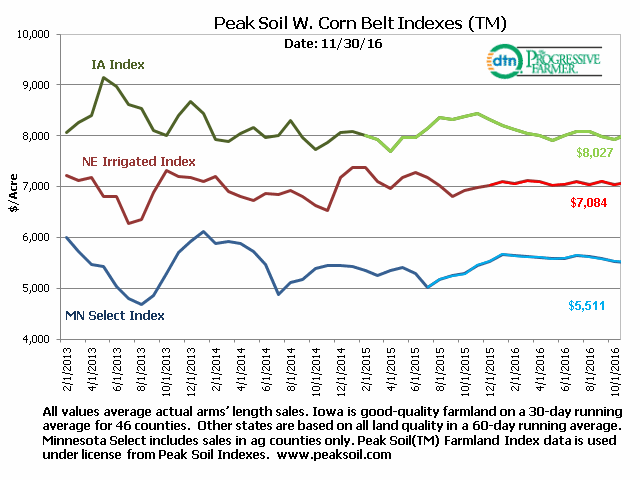
DTN Executive Editor Marcia Taylor reported late last week that, “Chicken Little alert: The sky isn’t falling on land values, argues Bruce Sherrick, director of the TIAA Center for Farmland Research at the University of Illinois. True, average prices have dipped the past two years. ‘But adjustments have been far less extreme than the change in income or commodity markets, debunking what you hear in the popular press,’ he says.
“‘I’m not going to predict where markets are headed,’ Sherrick told attendees at DTN-The Progressive Farmer’s Ag Summit this week. ‘But capitalization rates of Illinois farmland values (rents divided by land values) closely track with 10-year Treasury bonds. Since 1970, the only time it’s been out of whack is the 1980s. If we’re in a farmland bubble, I can’t see it.'”
Ms. Taylor noted that, “Admittedly, Iowa’s values may have slipped about 12%, according to Peak Soil Indexes — more than other I-states. But Iowa also experienced a larger uptick during corn’s boom years. Actual sales of good-quality Iowa cropland even bounced back over $8,000 an acre in November (see chart). Both Minnesota and irrigated Nebraska cropland remained relatively stable in those same studies, supporting Sherrick’s thesis.”
The DTN article added that, “But lenders remain cautious should more sales filter through the market in the year ahead. MetLife Agricultural Finance, one of the nation’s leading mortgage lenders, expects U.S. farmland’s ‘first significant corrections since the mid-1980s’ with an average 20% slump from peak values by 2018. Thirty years ago, land values crashed more than 40% in the space of a few years.
“Rabo AgriFinance analyst Sterling Liddell believes Midwest land values already may be off 10% to 15% from highs in many areas, with prospects for up to 25% decline from peak by 2018. He worries that ‘new corn’ regions in the central Dakotas, eastern Nebraska and Kansas could contract even more as low corn prices weed out least-productive farmland.”
The DTN item also pointed out that, “Even a 20% to 25% haircut in peak land values is no catastrophe. Most row-crop areas in the U.S. saw double-digit, year-on-year growth in nine of the 12 years prior to 2014, Rabobank says. Midwest farmland will ultimately be settling at about 2012 values, Liddell believes, with most farm landowners retaining plenty of their lifetime wealth in real estate.”

